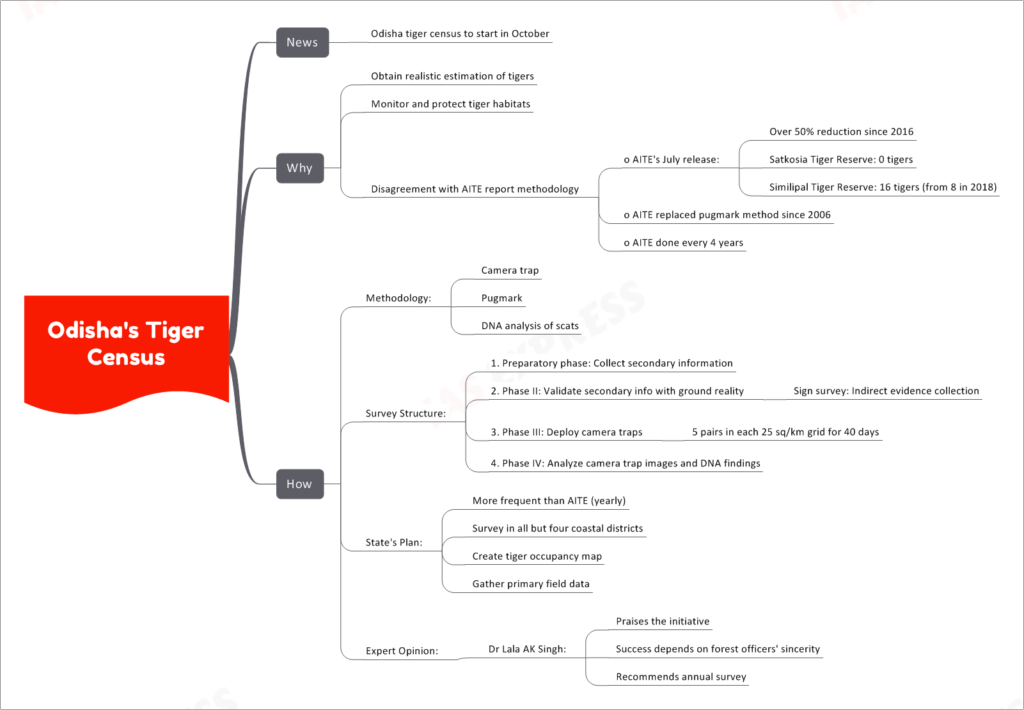Odisha’s Tiger Census

In recent news, Odisha has embarked on a crucial mission to conduct a comprehensive tiger census. This initiative aims to obtain realistic estimates of the tiger population, monitor and protect their habitats, and address disagreements with the methodology and findings of the All India Tiger Estimation (AITE) report.
Why Odisha’s Tiger Census?
Obtain Realistic Estimations
One primary goal of this census is to obtain accurate and realistic estimations of the tiger population within the state. This is essential for effective conservation efforts and management.
Monitor and Protect Tiger Habitats
Conserving tiger habitats is crucial to ensure the long-term survival of these magnificent creatures. The census helps in monitoring these habitats and implementing necessary protective measures.
Disagreement with AITE Report Methodology
Odisha’s decision to conduct its tiger census stems from disagreements with the methodology and findings of the AITE report. The AITE report, released in July, indicated alarming statistics, including a 50% reduction in tiger numbers since 2016, zero tigers in the Satkosia Tiger Reserve, and an increase from 8 to 16 tigers in the Similipal Tiger Reserve. The AITE had also replaced the traditional pugmark method with newer techniques since 2006, and it is conducted every four years.
How is the Census Conducted?
Methodology
The Odisha tiger census employs a comprehensive methodology that includes:
- Camera Traps: Utilizing camera traps to capture images of tigers and other wildlife in their natural habitat.
- Pugmark Tracking: Employing traditional pugmark tracking to complement modern techniques.
- DNA Analysis of Scats: Conducting DNA analysis of tiger scats (droppings) for identification and genetic research.
Survey Structure
The census is structured into several phases:
- Preparatory Phase: Collecting secondary information about tiger presence and habitats.
- Phase-II: Validating secondary information through ground-level surveys, including sign surveys that involve collecting indirect evidence of tiger presence.
- Phase-III: Deploying camera traps strategically, with five pairs in each 25 square-kilometer grid, for a duration of 40 days.
- Phase-IV: Meticulously analyzing camera trap images and DNA findings to determine the tiger population.
Odisha’s Comprehensive Plan
Frequency
Unlike the AITE, which is conducted every four years, Odisha’s approach to the tiger census is more frequent, with plans to conduct it annually. This ensures more up-to-date and accurate data.
Coverage
The census will cover all districts in Odisha except for four coastal ones, ensuring a comprehensive understanding of the state’s tiger population.
Objectives
The overarching objectives include creating a comprehensive tiger occupancy map and gathering primary field data to support informed conservation efforts.
Expert Opinions
Expert opinions play a vital role in assessing the importance and success of this initiative:
- Dr. Lala AK Singh, an expert in the field, has praised the effort and emphasized that its success hinges on the sincerity of forest officers.
- He recommends conducting the census annually to maintain an accurate and up-to-date record of the tiger population.
If you like this post, please share your feedback in the comments section below so that we will upload more posts like this.

